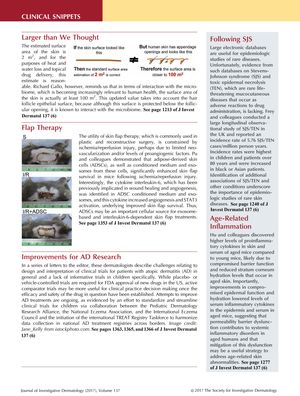Clinical Snippets: Skin Surface Area, Skin Flap Therapy, Atopic Dermatitis Trials, Stevens-Johnson Syndrome Incidence, and Aging Skin Inflammation
June 2017
in “
Experimental dermatology
”

TLDR Skin has a larger surface area than thought, certain skin cells improve skin flap survival, better trials for skin conditions in children are needed, Stevens-Johnson syndrome rates vary by age and race, and better skin barrier function may reduce inflammation in the elderly.
Richard Gallo highlighted that the skin's surface area is much larger than the commonly estimated 2 m² when considering interactions with the microbiome, with a more accurate estimate being at least 100 m² due to the inclusion of the hair follicle epithelial surface. In a study on skin flap therapy, Pu and colleagues found that adipose-derived skin cells (ADSCs), their conditioned medium, and exosomes significantly improved skin flap survival in mice after ischemia/reperfusion injury, with interleukin-6 playing a key role in enhancing angiogenesis and STAT3 activation. Dermatologists called for better-designed clinical trials for atopic dermatitis (AD), especially in children, and efforts are being made to standardize such trials internationally. Frey and colleagues reported an incidence rate of 5.76 Stevens-Johnson syndrome (SJS)/toxic epidermal necrolysis (TEN) cases per million person-years in the UK, with the highest rates in children and patients over 80, and increased rates in black or Asian patients. Lastly, Hu and colleagues found that aged mice had higher levels of proinflammatory cytokines due to compromised barrier function and reduced hydration in the stratum corneum, suggesting that improving barrier function could mitigate systemic inflammatory disorders in aged humans.



